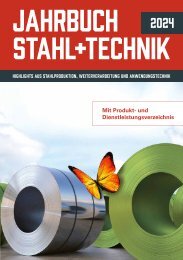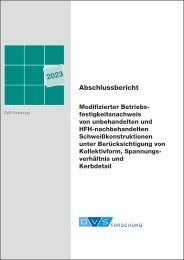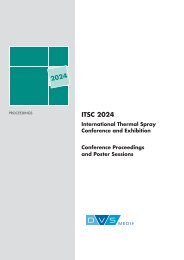STEEL + TECHNOLOGY 04/2019 EXTRACT
STEEL + TECHNOLOGY 04/2019 EXTRACT
STEEL + TECHNOLOGY 04/2019 EXTRACT
You also want an ePaper? Increase the reach of your titles
YUMPU automatically turns print PDFs into web optimized ePapers that Google loves.
64 | <strong>STEEL</strong> <strong>TECHNOLOGY</strong><br />
Practical improvements in surface inspection<br />
Classifying defects more reliably<br />
While AI-based technologies can now outperform humans in many categories of image processing, the<br />
“experienced” reliability of surface inspection systems in the steel industry often leaves much to be desired. In<br />
apparent contradiction to this, the very same systems are able to achieve high classification accuracy on<br />
controlled test data. A structured optimization of datasets and classifiers using deep learning technology<br />
drastically increases the practical performance of existing systems. For the best possible performance, surface<br />
defects must be classified multiple times throughout production.<br />
Modern requirements for cold-rolled<br />
flat steel products necessitate<br />
ever-higher production quality,<br />
especially for applications in the automotive<br />
industry. Manual inspection through<br />
the complete production process is often<br />
not possible due to both cost and organizational<br />
restrictions. For this reason, large<br />
steel manufacturers are dependent on the<br />
use of automated visual surface inspection<br />
systems. These systems consist of<br />
cameras and illumination devices located<br />
above and below the steel strip, hardware<br />
and software for defect detection and<br />
classification, as well as a software interface<br />
for the user. The correct classification,<br />
i.e. the determination of an image’s<br />
surface defect category, is the critical<br />
operational piece of the system. This classification<br />
itself is ultimately what enables<br />
the system to, for example, distinguish<br />
non-metallic inclusions from superficial<br />
dirt.<br />
Typically, the manufacturers of the surface<br />
inspection systems follow the steps<br />
of installing the systems on-site, optimizing<br />
the classifiers, and training future<br />
users. After acceptance, factory staff is<br />
then responsible for further optimization of<br />
these systems, with occasional support<br />
from system manufacturers. Frustration<br />
concerning poor classifier performance is<br />
often directed towards these internal<br />
employees, despite that they have tuned<br />
the classifiers optimally given their information<br />
constraints. To make matters<br />
worse, the technologies behind the operation<br />
of these classification systems are<br />
trade secrets of the inspection system<br />
manufacturers and only the most rudimentary<br />
optimization tools are made available<br />
for use. Making improvements to the identified<br />
weak points of the systems is practically<br />
impossible in many cases.<br />
Both the surface inspection system<br />
manufacturer’s specifications and scientific<br />
literature give consistently high values<br />
for classification accuracies. Often, accuracy<br />
levels of 95% or more are declared.<br />
However, the employees who are responsible<br />
for quality control find that, in production,<br />
the classification results tend to be<br />
much more unreliable.<br />
In the following section, the most<br />
important reasons behind this discrepancy<br />
are explained and possible solutions are<br />
presented. Smart Steel Technologies<br />
(SST) offers a wide range of software tools<br />
that significantly improve classification<br />
performance in practice without the need<br />
to replace existing inspection systems<br />
consisting of expensive integrated imaging<br />
systems (figure 1).<br />
Training and test sets<br />
To build a classifier that can properly classify<br />
all types of surface defects, training<br />
sets and test sets that contain represent-<br />
Figure 1. Deep learning technology is superior to conventional methods of surface defect classification (Picture: SST)<br />
Authors: Dr. Falk-Florian Henrich, Founder and CEO; Dr. Otmar Jannasch, VP Metallurgy; Dr. Jan Daldrop, Machine Learning<br />
Engineer; Selim Arikan, Machine Learning Engineer; Matt Fabina, Director of US Operations; Smart Steel Technologies, Berlin,<br />
Germany – Contact: henrich@smart-steel-technologies.com<br />
<strong>STEEL</strong> + <strong>TECHNOLOGY</strong> 1 (<strong>2019</strong>) No. 4


















